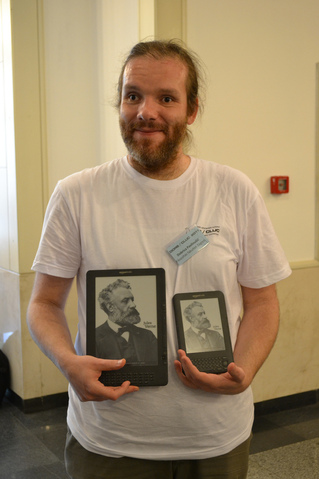 As some of you already know, almost a moth ago we placed order for our first Kindle (3G with wifi). Week after it arrived, we also ordered bigger DXG to complement our reading habits. So why do we have two Kindles and do we have regrets with them? Well, no! This post will try to summarize what I learned since...
As some of you already know, almost a moth ago we placed order for our first Kindle (3G with wifi). Week after it arrived, we also ordered bigger DXG to complement our reading habits. So why do we have two Kindles and do we have regrets with them? Well, no! This post will try to summarize what I learned since...
For a start, both devices have ARMv6, but K3G has 256 Mb of RAM while DXG has only 128 Mb. Both have 4Gb of flash of which about 3.5Gb is available for user content. Both have working 3G connectivity in Croatia. wpa_supplicant on Kindle won't allow connections to "enterprise" networks (like EduRoam). Smaller K3G is just too small for reading pdf files. Bigger DXG has e-paper in A5 size, so it's much more useful, but comes with older 2.5.8 firmware which has terrible browser (Netfront as opposed to WebKit in 3.1) and pdf reading without contrast settings (which is very, very useful).
But, I was fortunate enough to find mobileread forum post on migration of 3.1 software from K3G to DXG by Yifan Lu to whom I'm eternally grateful for much needed software upgrade.
However, even if you don't want to upgrade Amazon's own firmware, there is Duokan alternative reader software for Kindle. It has superb support for two column pdf files which allows you to just press next page key and read column on the left (from top to bottom) and then on the right (from top to bottom). It has also various other layouts for reading, and it makes smaller Kindle almost useful for pdf reading (and reading on bigger one a joy).
But, sooner or later, you will come across pdf which would really benefit from manual cropping. Take a look at briss which is cross-platform application for cropping PDF files.
While we are at software, you should really look at mobileforum's Kindle hacks thread which documents latest jailbreak (which will give you root permissions on Kindle), usbnetwork (to connect over USB cable) and various fonts and screensaver hacks.
Development for kindle can be done using Java2ME (remember that from cell phones?). However, Amazon doesn't actually seem to give out it's Kindle development kit but don't despair: Andrew de Quincey figured out a way to develop kindlets without the KDK. With KDK API from Amazon and JSR217 specification for Java2ME you can be in your marry Java development in no time.
I would like to see something like OpenInkport running on Kindle. This would allow free software developers to take full power from this nice e-paper device. If only I didn't have so much books to read...